Office Party Dresses for Women in Early 20s
Once housework was done, 1920s women would put away their house dress and apron and head out for the day. Running errands, visiting a neighbor, working in a factory or office, or going to town for a White Castle burger and matinée movie all required a woman to dress well yet still enjoy the comforts and freedoms of semi casualness.
The 1920s day dress was the one garment women wore the most often. It could be simple or dressy, depending on the destination. Fancier afternoon dresses were built on the same design principles as semi-casual day dresses, but with richer materials and more trim.
Shop 1920s style day dresses.
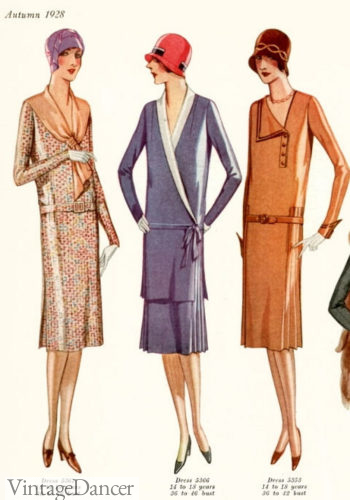
1928 tailored day dresses with cloche hats
1920s Day Dress Fabrics
The primary difference between house, day and evening dresses were the fabrics and patterns or the amount of trim. Fabrics for house dresses were mostly cotton in cheerful prints like plaid, checks, gingham and polka dots. Fabrics for day dresses ranged from casual jersey, batiste, wool, linen, knits, crepe, and rayon to fancier silk, taffeta, organdy, and velvet. The richer fabrics raised a woman's status from a common housewife to a charming socialite. Each fabric was light, even in winter, with incredible draping abilities. Velvet was as soft as butter. Crepe de chine was beautifully delicate. Cotton was thin and almost sheer. These are fabrics that are difficult to find in most crafting fabric shops today. Learn more about colors and fabrics in the 1920s.
Since these were not fancy parties, the colors were usually solid tones. In the fall and winter there was black, mauve, purple, blue, sage green, and burnt orange. In the summer Nile green (similar to jade), sunset orange, French blue (powder blue), white, and maize (light yellow) were the trends.
These light, crispy, fabrics swished and swayed as a woman moved. The body was still but bell sleeves, tiered skirts, and long neck and belt ties added movement around the perimeter.
Solid colored dresses with matching or contrasting trim were more common than prints for most of the 1920s. In spring and summer, patterns emerged in the form of small florals, geometric prints, windowpane, plaid, and polka dots. Decorative trim was usually in the form of embroidery, soutache, pintucks, smocking, neckties, belts, sashes, large collars, buttons, bows, and flowers.
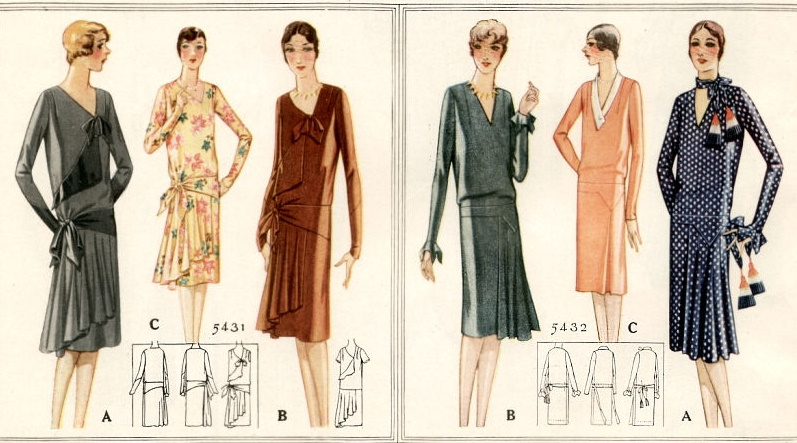
1927 winter day dresses with long sleeves
Advertiser
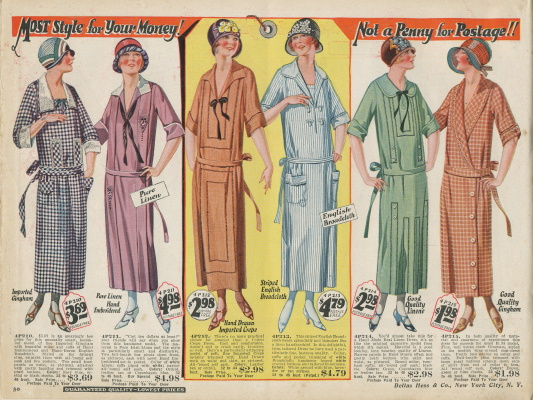
1924 spring dresses for house or daywear
1920s Day Dress Trim
Because dress shapes were fairly simple, designers had to use beautiful fabrics with tasteful but minimal trim. Some embroidery on the cuffs, collars or skirts heightened the sophistication of the day dress. A large flower made of fabric or ribbon on the shoulder or hip was another simple adornment. Ruffles of fabric were not usually used on the skirt hem but instead down the bodice or skirt side. The true art of 1920s dress design was in the architectural placement of vertical and horizontal lines.
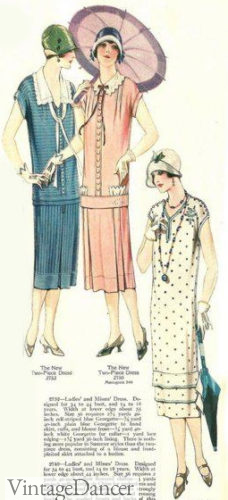
1925 extra low drop waistline dresses with collars, neck ties and tiered skirts
Women's 1920s fashion was all about elongating the body. Tall and thin was the "in" shape. Trim and accent were placed in long vertical lines. Long rows of a button, long collars and neckties, vertical pintucks and pales of embroidery each accent vertical line. Draping on one or both sides of the skirt added to the illusion of length. Box pleating, hanky hems, asymmetrical hems, and tiered layers were common on skirts in the mid to late '20s.
Advertiser
Horizontal lines came in the form of the belt, ruching around the neck and shoulders, and trim on the bottom edge of the skirt. The placement of those horizontal lines drifted from a relaxed natural waist in 1920-22, to no-waist or extra-long drop waist in 1922-1925, to hip level dropped waist for the remainder of the decade.
A fabric tie belt, buckle belt, or sash in the same or contrasting color was worn low on the waist or around the hip for most of the 1920s. The thickness of the belt is something that is associated with the year. Wide sashes on the middle or low waist were the most common in the early '20s while thin and low hip lines were common in the middle to late 1920s. While this was the general trend, it was really up to the woman to decide what thickness and at what waist location was the most flattering on her body. Many dresses lacked any sort of beltline. Instead, the dress fell freely from shoulder to hem create a tube or column shape.
The illusion of length was magnified by illustration artists of the day. Fashion drawings were typically twice as tall as any real living women. This made it especially difficult for women to live up to — but they tried!
Although "thin and "tall" seem to be interchangeable terms in fashion, you don't have to be thin in order to create the illusion of height. The long vertical lines on '20s dresses were very flattering to full figured women. While showing off an hourglass figure was out of fashion in the 1920s, this didn't mean a dress fit like a potato sack. Indeed, dresses were almost always handmade and tailored to flatter a woman's unique body. Shaping around the torso, chest, arms, and hips was possible without losing the overall boxy silhouette. This is the reason I am very adamant about 1920s clothing being the era that is flattering on most body types with careful selection of dress style, fabric, and fit.
Many of the fashion guidelines for plus size women appeal to the mature or Mrs. older woman as well.
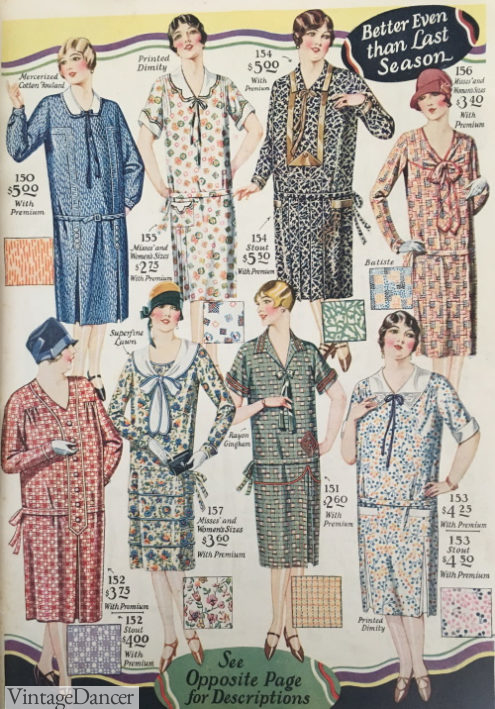
1928 day dresses for plus size ladies
1920s Day Dress Necklines
One of the defining characteristics separating 1920s dresses from those of other decades is the necklines. Both dresses and blouses shared similar neck shapes. One shape very unique to the 1920s was the Bateau, also called boat or scoop neckline. The very wide round opening made it possible for the dress to be slipped overhead, eliminating the need for buttons and hooks or maids/servants to dress women. The leisureliness of the boat neck shape and ease of use went right in line with everything else about the effortless '20s.
There was quite a bit of other sea-faring influences besides the boat neck shape. Square sailor necks or deep V-necks with long bow ties were also borrowed from men's sailing uniforms. The wide and long shawl collar was borrowed from the fisherman's knit sweater. While the wide boat neck quickly faded from the early 1920s in favor of medium size round or pointed Chelsea collars (peter pan collars), the sailor bow tie remained fashionable the entire decade.
The later 1920s didn't see a change in collar shapes, but rather in size. Deep V-necks shrunk up to narrow V's, large round collars reduced to small Peter Pan collars, pointed collars became daintier, and even boat necks gathered in so that a single button at the back was necessary to pull over and fasten on.
All necklines were modest. If a deep V was used, another piece of fabric backed the opening to create a square neck instead. Collars framed the shoulders and face but never called attention to any sort of bosom (Women had breasts? Not in the '20s!).
1920s Day Dress Sleeves
The other defining characteristic of day dresses was the shape of the sleeves. Except for evening wear, most day dresses were long-sleeved. Fitted sleeves had little extra room in the shoulder or arm and fit straight down to either a full length with a wrist cuff.
Short sleeves were reserved for summer and only for women with pretty arms. Short sleeves could mean just above the elbow or an almost sleeveless cap sleeve. Sleeveless day dresses were taboo unless a matching silk or sheer jacket was worn over it.
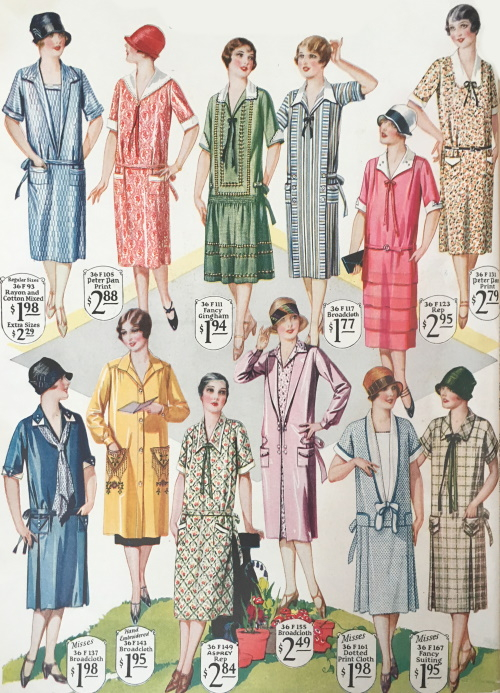
1927 short sleeve day dresses for spring/summer.
Another common and unique long sleeve was the bell shape. They gradually went from fitted at the shoulder down to triangle or bell shape at elbow or forearm. Bell sleeves were quite open and comfortable compared to the fitted sleeves, although the longer lengths had a tendency to hang off the arm and into food while out for tea with friends.
The third most common long day sleeve was called the bishop. It had small gathers at the shoulders for more ease and then ballooned down the arm and gathered again at the wrist with a thin cuff. It was a perfect balance between a sleeve that allowed freedom of movement and modest covering. It remained very common for at least the next two decades and can still be seen in clothing today.
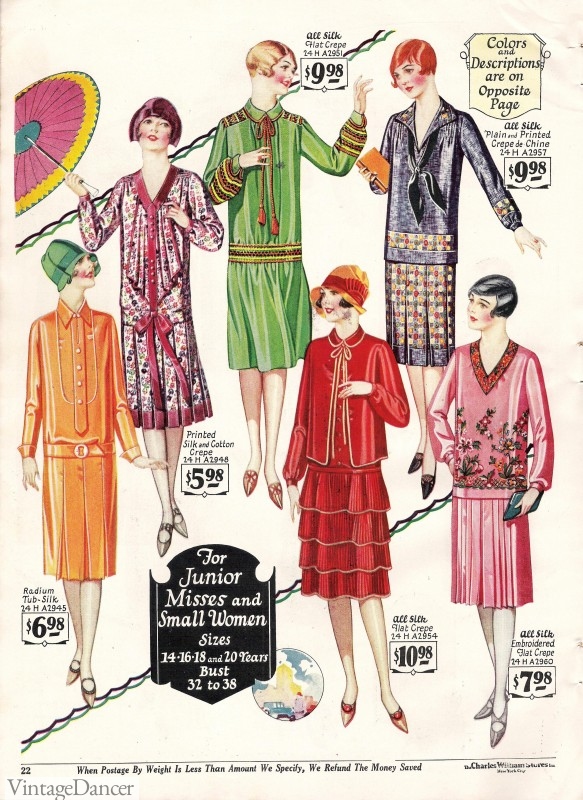
1927 Summer Day dresses. Streamlined straight cuts with thin belts, fitted and bishop sleeves, and low drop waists.
These were not the only collar and sleeve styles of 1920s clothing, but they were the most common on day dresses throughout the 1920s.
1920s Day Dress Skirts
The lower half of a 1920s day dress had the most interest, movement, and fun compared to the tops. Full gathered skirts in the early years were the least restrictive of the 1920s fashions. Some had large tiers or flounces reminiscent of the early Victorian age. The slender column-like skirt took effect after 1922. Side-pleats allowed some movement, but most women solved the problem by just shortening the dress hem to a comfortable level. By 1927 dress lengths hovered at their shortest, just a hair below the knee.
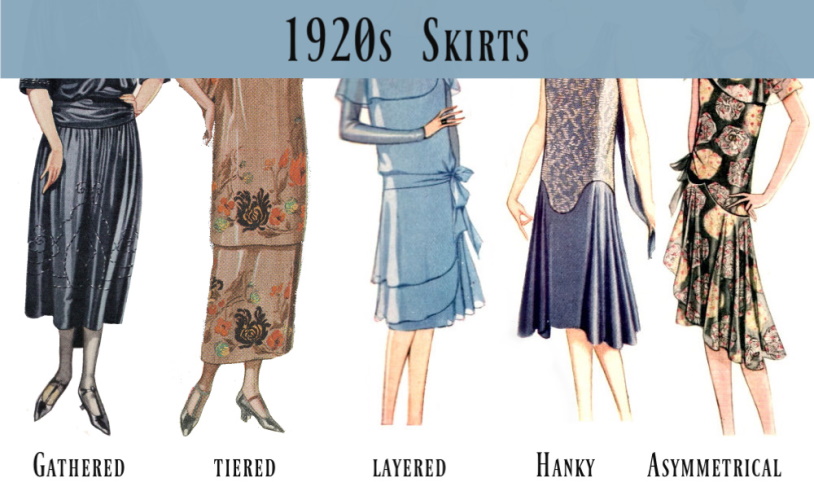
1920s skirt shapes – gathered, tiered, layered, hanky hem and asymmetrical
Skirts took on box pleats, accordion pleats, side draping, hip gores, and tiers of horizontal or asymmetrical flounces. Skirts looked lean and slender while standing, but had rhythm and sway while on the move.
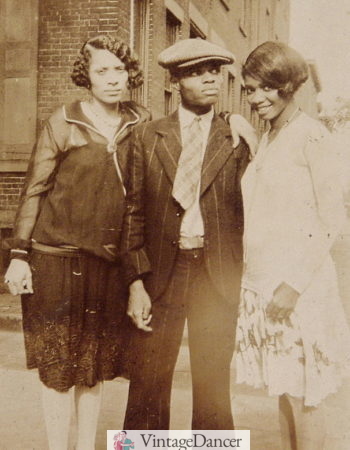
1920s embroidered gathered skirt on the left, flounced hem on the Right
1920s Day Dress Styles by Year
Looking at these illustrations from 1920 to 1929, you can see the progression of daywear with rising and falling skirt lengths. Changes in skirt shapes progressed from full hip/tapered calf to slender columns to flirty and flared skirts and sleeves.
More 1920s day dress history
- 1920s House Dresses History, Patterns
- 1920s Afternoon frocks and tea party dresses
- How to make a 1920s day dresses (sewing)
- Women's Suits – two-piece daywear for work, travel, and shopping
- Skirts and blouses– a casual day style
- Sporty knits and casual dresses- coming soon!
- Tennis clothes– a sport look for summer
- Pants, beach pajamas and other non dress daywear.
Shop 1920s Day Dresses, Patterns
Buying reproduction 1920s day dress is significantly more difficult than evening flapper dresses. There are only a small handful of companies making these types of dresses. Women who can sew are best making a 1920s day dress from a pattern. There are, however, many options to use or alter a new modern trendy dress that has many of the right details of vintage 1920s day dresses. This article should help you identify the current dress trends, or you can begin shopping below with the 1920s inspired day dresses I have found online.
Read: 1920s Style Dresses Today – new dress, 1920s styling. How to spot a 1920s style day dresses in stores near you (and online)
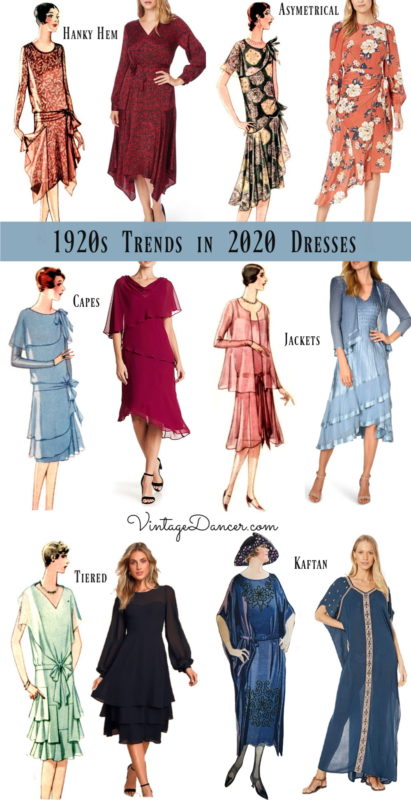
1920 meet 2020 with these trendy dress styles and more here.
Buy 1920s style dresses ideal for a daytime, afternoon, garden party or tea party event. Look here for additional plus sizes dresses.
Find a real vintage 1920s dress, 80s does 20s dress, or inspired dresses with vintage our search engine.
If you can sew, making a simple 1920s day dress will look the most authentic. See our review of the One Hour Dress before you use that popular pattern.
Source: https://vintagedancer.com/1920s/1920s-day-dresses/
0 Response to "Office Party Dresses for Women in Early 20s"
Post a Comment